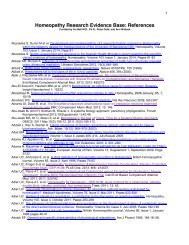core-operational-guidelines-for-telehealth-services
core-operational-guidelines-for-telehealth-services
core-operational-guidelines-for-telehealth-services
Create successful ePaper yourself
Turn your PDF publications into a flip-book with our unique Google optimized e-Paper software.
Core Operational Guidelines <strong>for</strong> Telehealth Services Involving Provider-Patient InteractionsNOTE ON THIS UPDATEThis update has four key modifications: 1) enhances guidance on educating patients about<strong>telehealth</strong> treatment; 2) adds several new items related to verification of patient/provideridentity and service delivery location; 3) provides guidance related to mobile devices and<strong>services</strong> delivered to patients in non-facility settings; and 4) expands <strong>guidelines</strong> on privacy andsecurity requirements.SCOPEThe following <strong>guidelines</strong> are fundamental requirements to be followed when providing medical andother healthcare <strong>services</strong> using telecommunications technologies, and any other electroniccommunications between patients, practitioners and other healthcare providers. The <strong>guidelines</strong> apply toindividual practitioners, group and specialty practices, hospitals and health care systems, and otherproviders of health related <strong>services</strong> where there are <strong>telehealth</strong> interactions between patients andservice providers <strong>for</strong> the purposes of health care delivery. These <strong>guidelines</strong> may apply to specialty<strong>services</strong>, but other <strong>guidelines</strong> and standards addressing specific specialties have been and continue tobe developed by separate workgroups within the ATA and other professional societies. When <strong>guidelines</strong>,position statements, or standards from any professional organization or society exist, healthprofessionals should also review these documents and, as appropriate, incorporate these into practice.These <strong>guidelines</strong> pertain primarily to healthcare professionals and patients located in the United States.In situations where either or both parties are not within the US, these <strong>guidelines</strong> may be referred to butany local <strong>guidelines</strong> that are in place shall be referred to and take precedence over these. [1,2]DEFINITIONSTerms and definitions that are commonly used in <strong>telehealth</strong>/<strong>telehealth</strong> are available on the ATAwebsite. [3] For this document there are several terms that need to be defined specifically:“Telehealth” - <strong>telehealth</strong> is the use of medical in<strong>for</strong>mation exchanged from one site to another viaelectronic communications to improve a patient’s health status. Telehealth includes a growing variety ofapplications and <strong>services</strong> using two-way video, email, smart phones, wireless tools and other <strong>for</strong>ms oftelecommunications technology. Telehealth is not a separate medical specialty. It is a delivery tool orsystem. Closely associated with <strong>telehealth</strong> is the term "<strong>telehealth</strong>," which may be used interchangeablywith <strong>telehealth</strong>, but is sometimes used to encompass a broader definition of health care that usestelecommunications technologies. Videoconferencing, transmission of still images and other data, e-health including patient portals, m-health, remote monitoring, continuing medical education, andmedical call centers, are all considered part of <strong>telehealth</strong> and <strong>telehealth</strong> (ATA, 2007).“Organization” - includes organizations, institutions, and business entities, including online serviceentities.“Health professionals” - refers to individuals.“Shall, should, and may” - This document contains requirements, recommendations, or actions that areidentified by text containing the keywords “shall,” “should,” or “may.” “Shall” indicates a requiredCopyright American Telemedicine Association Page 4



